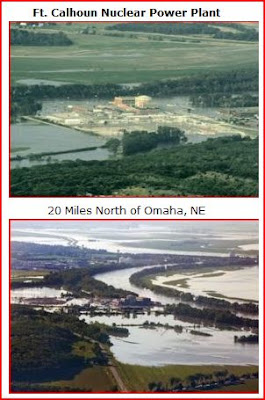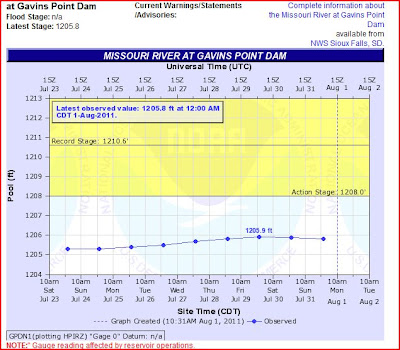

Missouri River dips below 18 feet in Bismarck-Mandan ND
The Missouri River briefly dropped below 18 feet in Bismarck-Mandan on Sunday morning but climbed again overnight.
According to National Weather Service, the river’s elevation was 17.95 feet at 10:45 a.m. Sunday, measured at a river gauge near Bismarck’s water treatment plant north of Memorial Bridge.
The U.S. Army Corps of Engineers has been gradually lowering releases from the Garrison Dam since late June, but the river has been falling slowly in response. It fell below 19 feet on July 13 for the first time since June 24. The weather service projects that it will remain around 18 feet until this weekend when it predicts that it will fall to 17.6 feet on Saturday.
Todd Hamilton, meteorologist with the weather service, said the river’s level was tied to dam releases rather than rainfall.
“I think you’d have to have a pretty hefty rainfall,” he said. “It’s not going to make it go up unless there’s a significant extended rainfall over the western part of the state.”
The corps is holding dam releases at 110,000 cubic feet per second until Thursday, when they will lower them to 105,000 cfs.
OMAHA.com | Levees may not be done by spring 2012 and could eclipse $1 Billion.
This is a race the Army Corps of Engineers expects to lose.
Corps officials say it's doubtful all the federal levees on the Missouri River can be repaired in time for next spring's runoff.
There is too much work to get done before next March, but the levees that protect "dense population centers" will get priority, Brig. Gen. John McMahon told The World-Herald Monday.
He also said the cost of repairing the levees and work on the river's six upstream dams in the Dakotas and Montana could eclipse $1 billion.
That includes only the corps' costs.
It excludes the millions of dollars homeowners and farmers lost in property and crops and the millions counties and cities shelled out to fight the flood. It also excludes state and county costs for fixing damaged bridges, roads and other infrastructure.
It's also not the final number.
"It's a running estimate," McMahon said.
The corps is starting to look toward the future as an end to this year's flooding approaches. By mid- to late September, the Missouri is expected to recede back into its banks, ending this spring and summer's flood.
However, McMahon and others cautioned that local and state officials and others need to stay just as vigilant in monitoring the system's levees, including those at Omaha and Council Bluffs.
"We're still fighting a pretty tough fight on some of those levees," said Col. Robert Ruch, commander of the Omaha district, noting a "large and aggressive" sand boil fought recently near Council Bluffs.
He said the threat of a levee breach remains real as long as the levees are holding back water.
Ruch also said the levees need to be monitored aggressively.
In Nebraska, the state in recent days turned over the monitoring of Omaha's levees to the city, removing the Nebraska National Guard. Omaha officials objected but said they would use city workers and private contractors to monitor the levees.
The corps expects to begin work on the levees as soon as the Missouri returns to its banks.
That work will not be easy.
First, it will take time for water on the flood plain to recede. Some of that water may be trapped behind roads, hills and other structures, requiring local officials and others to force the water back into the river.
The volume of water on the flood plain is three times the amount held in the reservoir at South Dakota's Gavins Point Dam, the corps said.
And, once the water recedes, contractors and others will have to wait until the ground is dry enough to get to and repair certain levees.
McMahon said the corps was unlikely to get all the federal levees back into pre-2011 shape for the spring thaw.
The good news is that a repeat of the 2011 flood is highly unlikely. The chances of it happening again: roughly 1 in 500, said Jody Farhat, director of the water management division of the corps' Omaha District.
"This was a rare event, and the chance of getting another event again next year is remote."
RadiationNetwork.com


Missouri River Dams and River Levels Flood Map
 http://www.mappingsupport.com/p/gmap4.php?q=https://sites.google.com/site/gmap4files/p/news/missouri_river.txt&ll=43.761599,-101.071993&t=h&z=6&label=on
http://www.mappingsupport.com/p/gmap4.php?q=https://sites.google.com/site/gmap4files/p/news/missouri_river.txt&ll=43.761599,-101.071993&t=h&z=6&label=onUS ARMY CORPS OF ENGINEERS FORECAST SCHEDULE OF RELEASES OF 6 MAINSTEM MISSOURI BASIN DAMS
Updated Daily
NOAA Hydrologic

http://water.weather.gov/ahps2/river.php?wfo=abr&wfoid=18696&riverid=203276&view=1%2C1%2C1%2C1%2C1%2C1%2C1%2C1&toggles=10%2C7%2C8%2C2%2C9%2C15%2C6&pt[]=145640&pt[]=142853&pt[]=144098&pt[]=144183&pt[]=142396&pt[]=143355&allpoints=143990%2C145585%2C145025%2C145026%2C144876%2C145027%2C143234%2C143184%2C145519%2C145640%2C144217%2C142150%2C142780%2C142853%2C145202%2C141586%2C144582%2C143543%2C144796%2C144098%2C144240%2C141320%2C141614%2C142968%2C144183%2C142574%2C143478%2C142193%2C142760%2C142003%2C142610%2C142396%2C144496%2C147345%2C141899%2C143355%2C142050%2C141570%2C144165%2C143476%2C141703%2C142023%2C144123%2C141863%2C143539%2C143436%2C141917%2C143009%2C142688%2C142640%2C143925%2C143734%2C142729%2C143790%2C142668%2C141962%2C142132&data[]=hydrograph&submit=Make+my+River+Page!
FT. PECK DAM - MONTANA

GARRISON DAM - NORTH DAKOTA

FT RANDALL DAM - NEAR CHAMBERLAIN SD

GAVINS POINT DAM - NEAR YANKTON SD

GARRISON DAM - NORTH DAKOTA

FT RANDALL DAM - NEAR CHAMBERLAIN SD

GAVINS POINT DAM - NEAR YANKTON SD

RESERVOIR CONTROL CENTER REPORTS
The following is the latest Reservoir Readings on the Upper Missouri River. This report is updated daily. Click on the picture for today's readings in reference to Gavins Point Dam, Ft. Randall Dam in SD, Big Bend Dam in SD, Oahe Dam in SD, Garrison Dam in ND and Fort Peck in Mt.
Link to daily report:
http://www.nwd-mr.usace.army.mil/rcc/reports/showrep.cgi?3MRDTAP7Link to daily report:
- The Cave's Archive of daily NW DIVISION OF THE US ARMY CORPS OF ENGINEERS RESERVOIR CONTROL CENTER DAILY REPORT
- The Cave's OVERFLOW website focused upon US Army Corp of Engineer's Mismanagement of the 6 Missouri River Basin Dams
- THE CAVE'S OVERFLOW - Archive of the Cave's Daily Flood of 2011 Updates






